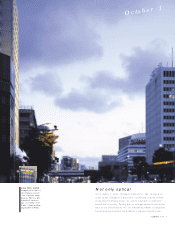Olympus 2004 Annual Report Download - page 12
Download and view the complete annual report
Please find page 12 of the 2004 Olympus annual report below. You can navigate through the pages in the report by either clicking on the pages listed below, or by using the keyword search tool below to find specific information within the annual report.
2 0 %
SALES RATIO O F
CPP SYSTEM S IN
THE UN ITED
STATES
This system is alrea dy
a part of the co st per
pro cedure (CPP) ser-
vice lineup available
in the U.S., acco unting
for appro ximately
2 0% of sales in the
gastro intesitinal endo -
scopy field.
a cle ar visio n: we no longer simply sell equipment; we change
1 0 O LYMPUS 2 0 0 4
NEW BUSINESS MO DELS IN THE MEDICAL IN DUSTRY
> In respo nse to changes in the medical industry, the Medical
Systems G ro up has developed a series of new products and
business models centered aro und two core systems: a per use
charging system fo r endo sco pic pro cedures and a nursing o per-
ations suppo rt system.
Q.1:
The medical industry is said to be going through a period
of radical change. W hat sorts of changes are taking
place?
>Co ntrolling medical costs is one current issue we see at the
state level. Co untries aro und the wo rld have all strugg led with
this same issue in various ways. In Japan there is a movement
to transform national universities and hospitals into indepen-
dent administrative institutio ns, and measures are being taken
to alter the base for insurance costs.
Until recently ho spitals in Japan have been able to operate
without reg ard for pro fitability, but they are no w increasingly
co ming under pressure to evaluate inco me and co ntro l o utput like
any o rdinary corpo ration. Physicians are confused by the busi-
ness o f running a ho spital, and the number o f cases where
administration is o utso urced to specialist organizations is
increasing. As administrative belts tighten, the way that medical
equipment is purchased also changes. Purchasing decisio ns have
been ceded fro m do ctors to hospital administrato rs, with the result
that these decisions are made on the basis o f co st-effectiveness.
Also , the changing nature of the docto r-patient relatio nship
cannot be overlo o ked. Because information on docto rs and
new technologies can easily be fo und on the Internet and in
o ther sources, patients are beg inning to be more selective o f
the medical care they receive, cho o sing ho spitals they prefer.
These changes are occurring in all develo ped countries.
Accordingly, it is necessary fo r the medical equipment industry
in Japan to also change. A business mo del that relies on the
purchase o f equipment with “functional value,” suited to specif-
ic care needs, is no lo nger sufficient—we must co mpete by pro -
viding “usag e value,” that is, the services that physicians and
hospitals are able to offer. This means that when we develo p
medical equipment we must take into consideration not just the
Ko ji Miyata,
President o f the
Medical Systems
G ro up
オリンパス AR04 04.8.4 14:05 ページ 10
























